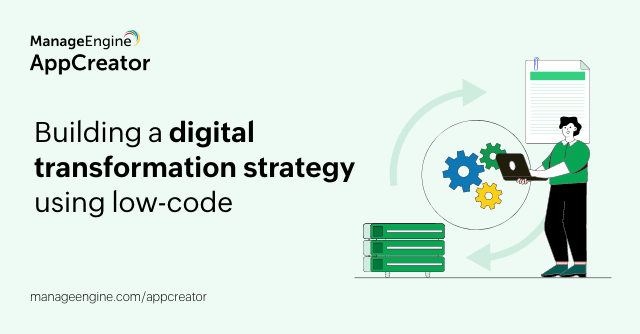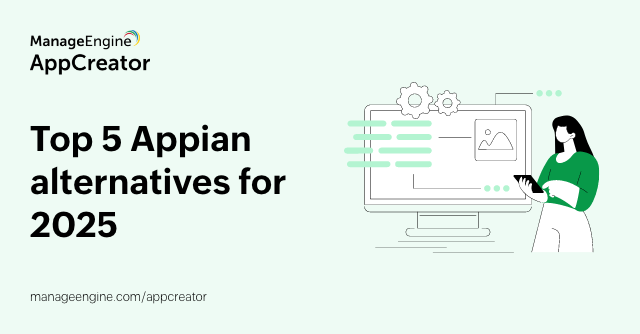Harnessing low-code for digital transformation
- Last Updated: June 3, 2025
- 227 Views
- 4 Min Read

What is digital transformation?
Digital transformation: Leveraging cutting-edge technology to overhaul organizational processes, resulting in improved efficiency, productivity, and profits.
Is your organization bogged down by outdated processes? Is your productivity plummeting? Digital technology can help you rethink and revamp your transformation strategy.
Organizations can use technology to overhaul almost any process. And in today's landscape, every organization needs to embrace digital transformation—or fall behind.
The goals of digital transformation are to:
Streamline process execution.
Improve efficiency.
Enhance productivity.
Surpass KPIs.
Accelerate growth.
Ensure viability.
There are a multitude of technologies available today that can affect digital transformation in an organization. Some prominent examples of digital transformation technologies are:
1. Low-code platforms.
2. Cloud computing.
3. Artificial intelligence (AI) and machine learning (ML).
4. Internet of Things (IoT).
5. Blockchain.
Low-code platforms as a tool for digital transformation
Of all these technologies, low-code offers versatility, speed, and ease of adoption, making it the most capable of effective, lasting digital transformation.
Let's take a look at how you can leverage low-code platforms, like ManageEngine AppCreator, to implement digital transformation seamlessly in your organization.
What is low-code?
Low-code is an approach to application development that uses minimal coding. How is application development possible without heavy coding? Low-code platforms provide a drag-and-drop interface, allowing users to decide how their applications are used for digital transformation processes. The platforms take care of all the back-end technicalities.
What about the coding requirements? Low-code platforms like ManageEngine AppCreator provide scripting assistance for the minimal coding required, allowing users to granularly configure custom logic in their applications. In the case of ManageEngine AppCreator, the scripting language used is called Deluge. Its syntax is similar to written English, so the learning curve for Deluge is low.
Check out for a few low-code examples!
Key features of low-code platforms
Visual application building
Build applications using a visual, What-You-See-Is-What-You-Get (WYSIWYG) interface.
Minimal coding
While basic coding may be needed to implement custom logic, most of the time you can achieve digital transformation with little to no coding.
Easy to learn
Empower your organization's line of business users to create apps on their own, with limited technical knowledge required.
Collaborative
Increase collaboration between your IT and business teams. Empowered by low-code platforms, business teams can reduced dependence on overworked IT teams, enabling them to focus on process optimization and innovation.
Seamless integration with existing systems
Whatever legacy architecture you may have, you can easily integrate with it by leveraging low-code platforms.
Multi-platform deployment
With low-code platforms like ManageEngine AppCreator, get one-click deployment for the web and iOS and Android platforms.
Rapid prototyping
Build working, enterprise-grade application prototypes in minutes, not days.
The difference between low-code powered digital transformation and conventional approaches
Feature | Low-code powered digital transformation | Conventional digital transformation approaches |
Speed of deployment | Deploy enterprise-grade applications in hours. | Takes a few weeks to release a prototype. |
Technical expertise required | The learning curve is small. Even line of business users can develop applications in a short time span. | Requires a high technical proficiency. Professional programmers are needed to deliver working solutions. |
Ease of integration | Pre-built custom connectors allow for easy integration with legacy architecture. | Integrations must be manually engineered from the ground up. |
Updates | Automatic updates come from the platform provider. Users need to update only the logic of the applications. | Updates have to be taken care of diligently by the development team and are often time-consuming. |
Check out more features of low-code platform here!
Benefits of using low-code for digital transformation
Across enterprises, low-code platforms are beginning to play a significant role in digital transformation. At each stage, from prototyping to deployment, maintenance, and upgrades, low-code platforms:
Accelerate processes.
Economize expenditures.
Empower stakeholders.
Drive growth.
Ensure organizational viability.
Enhance profits.
With the powerful and versatile nature of low-code platforms, a sound digital transformation strategy can be fully harnessed and realized.
Forming a digital transformation strategy typically involves the following steps.
Step 1: Analysis
Digital transformation strategists conduct an analysis of the entire organization and its processes from the ground up. Processes are classified based upon the viability of digital transformation. Only those processes that are deemed worthy of being subject to digital transformation make the cut.
Step 2: Specify stakeholders
For each of the identified processes, the pertinent stakeholders are identified.
Stakeholders can be classified as:
Internal stakeholders:
C-level executives.
IT teams.
Development teams.
Employees from other departments.
External stakeholders:
Customers.
Governments and regulatory entities.
Third-party vendors.
Investors.
Analysts and thought leaders.
Identification of stakeholders will assist the digital transformation strategists to define who will be responsible for what tasks in the digital transformation process.
Step 3: Design, develop, and implement the solutions
The next step is the design phase. For a given business process, the entry and exit criteria are first identified. Entry points signal the inception of a process, while exit points signify process completion.
The ManageEngine AppCreator low-code platform uses the five A's for optimal solution engineering.
1. Assess
Assess the business process. Create a "digital transformation requirements" document, stipulating what's required to transform each process from its current state digitally.
2. Analyze
For the process that's to undergo digital transformation, perform a thorough analysis of its metrics.
3. Architect
Create the necessary modules using the low-code platform's drag-and-drop builders, including the business process workflow builders needed for digital transformation.
4. Apply
Deploy the digitally transformed process by pushing it to live.
5. Audit
Gather feedback generated from the execution of the digitally transformed process. Use this feedback to identify pain points and areas of improvement. The low-code platforms' dashboard feature will help with this.
6. Adapt
Based upon the feedback gathered, adapt the digitally transformed processes for optimal efficiency.
Step 4: Loop
For all the business processes that require digital transformation, repeat the actions from step 3. This will ensure thorough coverage of all of these processes.
Check out the benefits of low-code!
Leverage ManageEngine AppCreator for your organization's digital transformation needs
ManageEngine AppCreator is a pioneering on-premises, low-code digital transformation platform, which accelerates digital transformation in your organization. With AppCreator, you can implement your digital transformation strategy affordably and realize results much faster than conventional methods.



